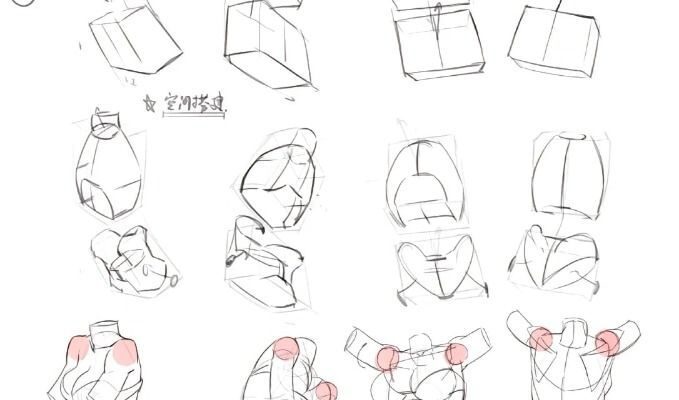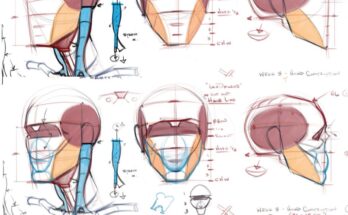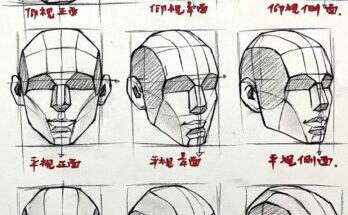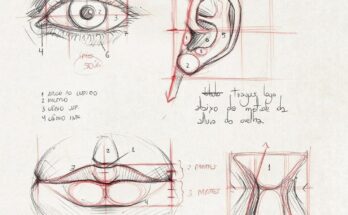Step-by-Step Tutorial on Drawing a Serene Forest Nymph: Anatomy, Floral Elements, and Atmospheric Lighting for Fantasy Illustration

Drawing a serene forest nymph—a graceful embodiment of nature’s spirit—offers artists a chance to fuse human anatomy with botanical fantasy, perfect for fantasy art, book illustrations, or ethereal game designs. This in-depth tutorial is inspired by a reference sketch titled “Forest Nymph,” which depicts a slender female figure with flowing hair interwoven with leaves and flowers, standing in a gentle pose with one arm raised. Rendered in pencil with soft shading, the image includes red construction lines to guide the pose’s fluidity, joint placement, and floral integration, while annotations highlight key features like the leafy crown, vine-wrapped limbs, and a misty forest backdrop. The composition evokes a tranquil woodland scene, blending realism with mythical charm, making it an ideal foundation for artists seeking to capture nature’s enchantment.
This guide is designed for intermediate artists, whether working traditionally with graphite on textured paper or digitally using tools like Procreate, Photoshop, or Clip Studio Paint, where layers can manage base sketches, foliage, and effects. We’ll break it down into sections based on the reference: establishing the pose and anatomy, detailing floral and vine elements, refining the face and hair, and adding atmospheric context. Key techniques include using gesture lines for organic movement, layering leaf patterns for depth, and applying soft gradients for a glowing aura. This approach suits fantasy narratives, environmental art, or animated sequences, encouraging reference from human poses (e.g., yoga stances) or botanical studies (e.g., ferns, ivy). Start with light sketching tools (e.g., H pencil or 20% opacity brush), a ruler for symmetry, and an eraser for adjustments, progressing to B pencils or opacity builds for shading. Given today’s date—07:14 AM EDT on Saturday, October 25, 2025—this tutorial aligns with a soft morning light setting, enhancing the nymph’s ethereal glow.
Section 1: Establishing the Pose and Anatomy (Red Construction Lines)
The reference’s red lines provide a structural framework, capturing the nymph’s graceful stance and balance.
- Mapping the Gesture Line: Begin with a flowing red line from the head, curving through the arched back, hips, and raised leg, ending with a slight bend in the supporting foot. The image shows a gentle S-curve: the torso leans slightly forward, the right arm rises gracefully, and the left arm rests by the side. Draw this as a single, fluid stroke, about 6-7 head heights tall, to convey natural elegance.
- Marking Joints and Axes: Place red circles at key joints—shoulders, elbows, hips, knees, and ankles—scaling them to prominence (e.g., larger at hips for weight). Add axes along limbs: the right arm angles upward with a soft bend, the left arm hangs with a slight curve, and the legs stagger with the left knee raised. The reference’s three-quarter perspective suggests a viewer slightly below eye level, so tilt the horizon upward.
- Perspective and Balance: Use a two-point perspective with vanishing points off-canvas to the left and right, converging lines toward the chest and feet. Ensure weight shifts to the right leg, with the left leg lifted for poise. Tip: Pose in a mirror to feel the stretch. Common error: Over-straightening—keep lines organic. Exercise: Sketch 3 quick gestures of this pose (standing, dancing, reaching) using only red lines to build fluidity.
This step locks in the nymph’s serene movement, preventing stiff or awkward forms.
Section 2: Detailing Floral and Vine Elements (Botanical Integration)
The reference’s pencil work highlights the nymph’s connection to nature, with leaves and vines adding texture and depth.
- Anatomical Base: Sketch the torso as a tapered cylinder, wider at the shoulders (about 2 head widths) and narrowing at the waist, with hips flaring slightly. The arms are slender ovals, and the legs are elongated curves, with the image’s shading suggesting a lithe frame.
- Floral Crown and Hair: Draw the hair as flowing waves, interwoven with leaf shapes (e.g., fern or ivy) and small flowers (e.g., daisies or violets). The reference shows a crown-like arrangement at the forehead, with leaves radiating outward. Use overlapping ovals for leaves and circular petals for flowers, varying sizes for natural growth.
- Vine-Wrapped Limbs: Sketch thin, curling vines wrapping around the arms and legs, with tiny leaves sprouting at intervals. The image’s annotations suggest integration, so align vines with the gesture line’s flow, denser near joints. Add texture with light cross-hatching for bark and soft strokes for leaves. Avoid mistake: Overcrowding—limit vines to 20-30% of limb coverage. Exercise: Detail an arm segment with vines and leaves, then replicate on the leg.
This builds a harmonious nature-human blend, enhancing the nymph’s mythical essence.
Section 3: Refining the Face and Hair (Facial Features)
The reference’s head details draw attention, with the face and hair as focal points.
- Face Construction: Sketch the face as an oval with a delicate jawline, adding almond eyes with a soft gaze, a small nose, and full lips. The image shows a serene expression, so keep features symmetrical and gentle, with a slight tilt to match the head’s angle.
- Hair Detailing: Refine the hair with wavy lines, incorporating leaf clusters and flower buds. The reference’s flow suggests a breeze, so add subtle curls at the ends. Use light shading to suggest depth, with highlights on the crown for a glowing effect.
- Integration Tips: Align the face with the neck’s curve, ensuring the hair follows the gesture line’s arc. Common pitfall: Flat face—add a subtle shadow under the cheekbone. Exercise: Draw the head with face and hair, varying expressions (calm, curious).
These elements bring the nymph’s personality to life.
Section 4: Adding Atmospheric Context and Final Touches
The reference’s misty forest background and shading create a morning woodland scene, enhanced by 07:14 AM lighting.
- Environmental Context: Sketch a forest floor with mossy patches and tree trunks, a leafy canopy above, and distant trees as overlapping shapes. The image suggests a misty setting, so add faint fog layers. With 07:14 AM EDT lighting, use a warm golden wash for sunlight filtering through, casting shadows leftward.
- Shading and Highlights: Apply gradients on a Multiply layer—darkest under hair, arm folds, and leg base; brightest on the face, flower tops, and raised hand. Use the above-left light source implied in the image, adding specular highlights (small white dots) on leaves and skin for a dewy glow.
- Final Details: Add a butterfly or dew drops on leaves, faint light rays through the canopy, and a glint in the eye. The reference’s light shading hints at mist, so soften distant edges with a gray overlay (10-20% opacity).
- Critique and Adjustment: Erase guidelines, sign in a subtle corner (e.g., lower-right), and flip horizontally to check symmetry. Adjust shading if the nymph blends into the background.
Additional Professional Tips for Mastery
- Tools and Materials: 2H for outlines, 4B for shading; digitally, use custom leaf brushes. Reference human poses or plant photos.
- Common Challenges: Vine attachment errors—study ivy growth. For lighting, use morning forest references (e.g., 7-8 AM).
- Exercises and Resources: Daily: 20-minute nymph head studies with floral effects. Explore “Fantasy Art: The Art of Mythic Worlds” by Boris Vallejo or online botanical art tutorials.
- Extensions: Add a companion (e.g., a deer), vary seasons (e.g., autumn leaves), or depict a magical aura for narrative depth.
This tutorial harnesses the reference’s tranquility, guiding you to create a stunning forest nymph. Practice regularly, and explore our related guides for fantasy creature variations or woodland scenes!



